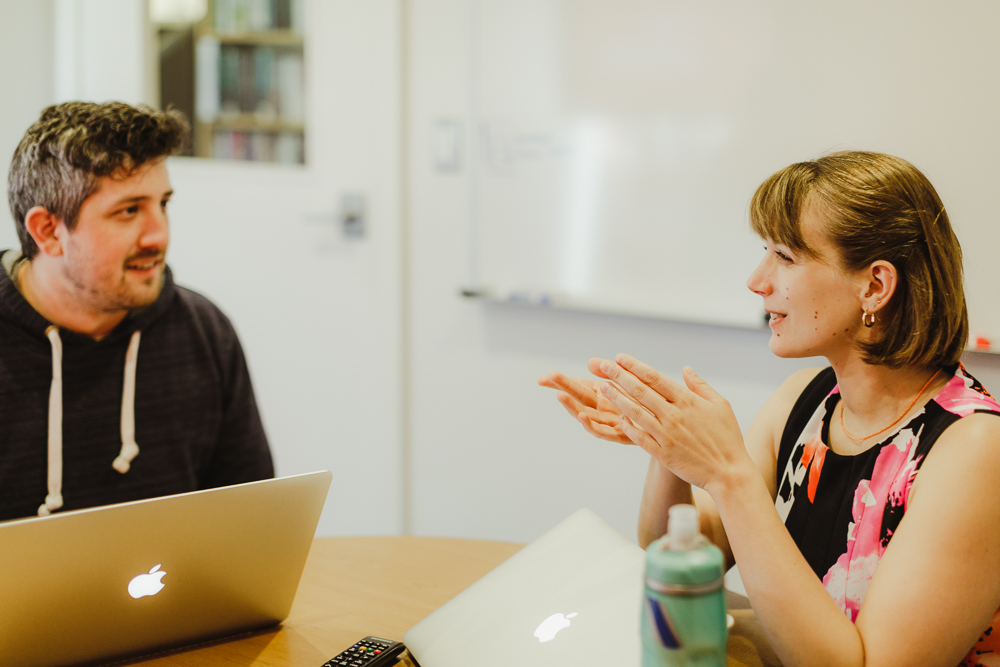I think it’s fair to say that, in general, designers prefer a blank canvas—a fresh start. But that’s not always the case. Sometimes we have to take over legacy projects or step into projects that are ongoing.
There are a few ways to make sure the engagement is positive for the client and fulfilling for the designer, too.
Bring the Energy
Not going to lie, burnout exists. That’s one reason that we rotate team members in and out of long engagements at Atomic. Not surprisingly, the stakeholders on the project are going to ride rollercoasters of burnout and energy, as well. That’s why it’s important to bring the energy! The team as a whole will feed off whatever new life you can inject into the project.
The best way to do this is to show enthusiasm and excitement in team and stakeholder meetings. Be the first one to stand up, grab a marker, and start sketching on the whiteboard. Or, introduce the team to a new Design Thinking activity, and talk about the success you’ve had implementing it on other projects.
Utilize Beginner’s Mind
Are you ever afraid to ask stupid questions? I am! But it doesn’t usually stop me. And when you come into an existing project, you basically get a free pass to ask as many “stupid” questions as you want.
Obviously, these questions aren’t really stupid at all. In fact, one person coming in with a beginner’s mind can make the group uncomfortable, but in a good way. You don’t know why certain decisions were made. You don’t carry that baggage. This allows you to push on team members and stakeholders. It may get disruptive. But a lot of times, the team may find that decisions made over a year ago don’t really apply anymore.
Case in point
Recently, I was working on a project that got some user feedback about how the app was using pagination on a table. We were told that it was too hard to get to the last page of results. I compared how the current app was built with what the previous designer had planned in mock-ups, and the solutions were quite different.
The pagination toolbar that was built had limited features, including previous page, next page, show X results per page, and total results. However, the total results number was only accurate to 500, and if there were more results, we represented the number as “500+.” This made it impossible to know how many pages of results there really were.
Obviously, somewhere along the way, a decision had been made to deviate from the original, full-featured toolbar. I was not a part of this decision. So I simply asked, “Why?”
The product owner on the client side told me that the way they originally built their data structure, we simply could not know how many results there were. But, pretty recently, we had rebuilt and streamlined the data structure. Now it was possible to know how many results there were and actually implement a full pagination toolbar!
Coming in with a fresh perspective and beginner’s mind allowed me to ask a naive question. Because the project was so large, this was a detail the team had simply overlooked. Until questioned, they had not realized that a decision from a couple of years ago didn’t apply anymore.
Have a Point of View
Designers all have different styles. The knock against taking over and leading a design engagement started by someone else is that you can feel handcuffed by someone else’s design decisions.
I’m not saying you should take everything they’ve done and throw it out. But I think it is a good opportunity to do a design audit. Look at what’s working well and what could use improvement. Identify inconsistent use of design patterns.
Bring up your findings with team members and stakeholders, and have a plan for how you could address the changes. Maybe not all of them will resonate, but everyone will appreciate the attention to detail you are bringing to the table.
Be a Good Role Model
Combining these three tips can make you the ideal new “leader” on a project. You are a welcome source of energy, you open the door for speaking up or questioning previous decisions, and you offer interesting new ideas for the team to build upon.

